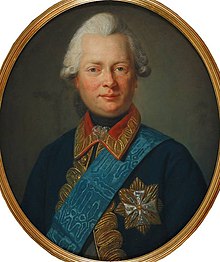Friedrich Erdmann (Anhalt-Koethen-Pless)
Friedrich Erdmann von Anhalt-Köthen-Pleß (born October 27, 1731 in Köthen ; † December 12, 1797 in Pleß ) from the Ascanian family was Prince of Anhalt-Köthen-Pleß .

Life
Friedrich Erdmann was the younger son of Prince August Ludwig von Anhalt-Köthen (1697–1755) from his marriage to Emilie (1708–1732), daughter of Count Erdmann II. Von Promnitz . Friedrich Erdmann was initially in the service of the Prussian army in August 1751. In July 1754, as captain of a company in the Prussian infantry regiment von Meyerinck ( No. 26 ), he got into financial difficulties and asked King Friedrich II several times for support from his father. On September 9th, 1755, he sought his departure from the cabinet, had to assure that he would not enter Austrian or imperial services, and received his dimission on October 10th, 1755 . Soon afterwards he switched to French military service. In the latter he participated, u. a. from March 10, 1759 as regiment owner of the Anhalt Infantry Regiment and commander of the Anhalt Brigade in the battle of Minden , on campaigns against Prussia and its allies, and left military service after the Peace of Hubertusburg in 1766. He went on trips to Russia . After the execution of King Louis XVI. he laid down all French military dignity and went back to the Prussian army, where he was lieutenant general from 1797.
In 1765 the estate of Pleß passed to the House of Anhalt-Köthen , which the last Count of Promnitz left to his nephew Friedrich Erdmann in return for a pension, which is why he assumed the title of Prince of Anhalt-Köthen-Pleß. Thus Pleß became a secondary school in Anhalt-Koethen. In 1767 he was officially enfeoffed with Pless by King Friedrich II of Prussia . Under the prince, described as entrepreneurial, industrial rule developed enormously. Friedrich Erdmann asserted his mountain shelf against the Prussian state and led the coal mining to flourish. From 1775 to 1776 he had a two-winged baroque palace built in Tichau .
Friedrich Erdmann settled Seiffersdorff Protestants in his rule in 1779 , to whom he granted many privileges. In the following year, Friedrich Schleiermacher's parents and their son also joined the emigrant colony.
Friedrich Erdmann was a knight of the Polish White Eagle Order . The Plessenburg in the Harz region was named after his reign of Pleß .
progeny
On June 13, 1766, Friedrich Erdmann married Countess Louise (1744–1784), daughter of Count Heinrich Ernst zu Stolberg-Wernigerode , at Wernigerode Castle , with whom he had the following children:
- Ernst (1768–1808), passed over in the line of succession due to “weakness of mind”
- Ferdinand (1769–1830), Duke of Anhalt-Köthen
- ⚭ 1. 1803 Princess Luise of Schleswig-Holstein-Sonderburg-Beck (1783–1803)
- ⚭ 2. 1816 Countess Julie von Brandenburg (1793–1848)
- Anna Emilie (1770–1830), heiress of Pless
- ⚭ Count Hans Heinrich VI. von Hochberg-Fürstenstein (1768–1833)
- Benedikt (1771–1773)
- Christiane (1774–1783)
- Georg (1776–1777)
- Heinrich (1778–1847), Duke of Anhalt-Köthen
- ⚭ 1819 Princess Auguste Reuss zu Köstritz (1794–1855)
- Christian Friedrich (born November 14, 1780; † August 30, 1813) in the battle of Culm
- Ludwig (born July 16, 1783 - † November 5, 1841), Prince of Anhalt-Köthen-Pleß
Honors
The Plessenburg in the county of Wernigerode was named after him.
literature
- Klemens Skibicki: Industry in the Upper Silesian Principality of Pless in the 18th and 19th centuries , Franz Steiner Verlag, 2002, p. 83 ff.
- Ferdinand Siebigk : Das Herzogthum Anhalt , Desbarats, 1867, p. 232
- Rolf Straubel : He just wants to know that the army belongs to me. "Friedrich II. And his officers , p. 116 and p. 686–687, BWV 2012, ISBN 9783830530176
Web links
Individual evidence
- ↑ cf. Karl Heinrich Siegfried Rödenbeck : Diary or history calendar from Friedrich's regent life ..., Volume 1, S.218, Berlin 1840
- ^ Johann Caspar Bluntschli, Karl Ludwig Theodor Brater: German State Dictionary , Volume 1, Expedition of the State Dictionary, 1857, p. 242
- ↑ Izabella Gawin, Dieter Schulze, Reinhold Vetter: Silesia: German and Polish cultural traditions in a European border region , DuMont Reiseverlag, 1999, p. 231
- ↑ German Journal for Christian Science and Christian Life , Volume 4, K. Wiegandt, 1861, p. 231 ( digitized version )
- ^ Daniel Schenkel: Friedrich Schleiermacher: a life and character picture , RL Friderichs, 1868, p. 10
- ^ Gerhard Heine: History of the Land Anhalt and its princes , Heine, 1866, p. 204
| personal data | |
|---|---|
| SURNAME | Friedrich Erdmann |
| ALTERNATIVE NAMES | Friedrich Erdmann, Prince of Anhalt-Koethen-Pless |
| BRIEF DESCRIPTION | German nobleman, Duke of Anhalt-Koethen |
| DATE OF BIRTH | October 27, 1731 |
| PLACE OF BIRTH | Koethen |
| DATE OF DEATH | December 12, 1797 |
| Place of death | Pleas |
